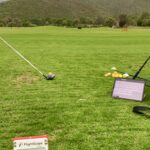The Power of Mental Strength in Golf: Why Values and Attitude Towards Play and Practice are Crucial
 As a golf instructor, I work with people daily. I recognize the crucial role that personal values play in the learning process and on the course. A golf student whom I consider adaptable is rarely burdened by mental stress during the learning process. Instead, they respond calmly and serenely to the challenges they encounter. These values not only influence performance on the course but also deeply shape the entire learning process.
As a golf instructor, I work with people daily. I recognize the crucial role that personal values play in the learning process and on the course. A golf student whom I consider adaptable is rarely burdened by mental stress during the learning process. Instead, they respond calmly and serenely to the challenges they encounter. These values not only influence performance on the course but also deeply shape the entire learning process.
Inconsistency or qualitative performance differences arise from:
– Strategic and tactical decisions.
– Adaptations in the training process.
– Differences in nutrition, sleep quality, and rest.
– Changes in motivation and self-confidence.
– Weather conditions and adaptation to different golf courses.
– Mental strength and handling distractions.
– Technique changes and/or lack of maintenance work
⇒ Values are the driving force behind every behavior. They determine what one does and how it is done.
Sign-up / request availability
Golf is wonderfully variable, making it an ideal discipline for developing a framework of action that allows for targeted responses and solutions. This can be particularly challenging for new golfers. Here are some typical triggering moments that require targeted action from the golfer:
– Difficult moments in the game or training.
– Uncomfortable situations.
– Unwanted actions.
Do you have a plan for handling such situations? It is important to know what to do, how to do it, and why to do it that way.
Here is our proposed solution: Let’s make a list of core values that define you as the athlete you want to be. Then, we’ll develop practical situations where we will guide our actions from these selected values.
By consistently applying this practical strategy, we can align our actions always with our ideal values. Let’s put these values into practice and observe the positive change in our game.
Sign-up / request availability
Here is a list of values that every golfer could have:
1. Discipline: Consistently follow a training plan and stay focused during training and competition.
2. Persistence: Overcome challenges and setbacks without giving up.
3. Patience: Take the time needed to make the improvement process positive and detailed.
4. Sportsmanship: Show respect towards opponents, officials, and the game itself.
5. Integrity: Be honest and fair, even when no one is watching.
6. Preparation: Be thoroughly prepared for every round or tournament.
7. Adaptability: Be flexible and adapt to changing conditions or unexpected situations.
8. Humility: Be humble in victory and gracious in defeat.
9. Passion: Have a deep love and enthusiasm for the game.
10. Consistency: Strive for consistent and reliable performance.
11. Growth: Have a drive for constant improvement.
Here are possible practical applications of my favorites:
Discipline:
“By following a structured training routine, assuming mutual accountability with training partners, and mental training, we can improve our focus and maintain discipline during long training sessions.”
Persistence:
“By setting short-term and long-term goals, maintaining a positive attitude through affirmations and reflective journaling, and seeking support from our network, we can overcome setbacks and develop persistence.”
Patience:
“Accepting that the learning and improvement process never ends, and that it is a path full of detours and obstacles until the goal is reached. This helps to maintain a positive attitude towards the learning process and makes the journey even more interesting. It doesn’t have to be, it can be.”
Preparation:
“Through detailed planning, physical and mental preparation, and regular review of our equipment, we can approach tournaments or counting rounds with confidence and readiness.”
Adaptability:
“By practicing under different conditions, cultivating an open attitude, and developing a variety of shots to handle different situations, we can be more adaptable and improve our performance under unexpected circumstances”.
Values-Based Decision Making
Goal of the Exercise: The exercise aims to assist golfers in consciously and consistently aligning their decisions on the course with their personal values, particularly in challenging or stressful situations.
Values-Based Decision Making Questions:
- Identification of the Moment: Recognize that you are in a critical moment.
- Reflection of Values: Which of your core values are relevant in this moment?
- Analysis of Options: What action options are available to you?
- Value-Based Evaluation: How do the various options align with your values?
- Decision Making: Choose the option that best aligns with your values.
- Action and Reflection: Execute the decision and reflect afterward on how well the action aligns with your values.
Practical Exercise
Preparation:
- Define Values: Each player writes down their most important values, such as Discipline, Perseverance, Patience, Preparation, Adaptability.
- Create Scenarios: The golf instructor creates various scenarios that may occur during a round of golf, such as a difficult shot, a long wait before teeing off, unexpected weather changes.
Conducting the Exercise: Facing a difficult shot
- Describe Scenario: The instructor describes a scenario, e.g., “You have a difficult shot ahead of you and feel uncertain.”
- Values Reflection: The player considers which of their values are important in this moment, e.g., Patience and Preparation.
- List Options: The player lists possible actions, e.g., choose a conservative shot or take the risk and attempt a difficult shot.
- Evaluation of Options: The player evaluates each option in terms of how well it aligns with their values:
– Conservative Shot: Aligns with Patience and Preparation, as it is safer and based on previous training.
– Difficult Shot: Could demonstrate Perseverance and Adaptability but risks undermining Patience. - Decision Making: The player chooses the option that best aligns with their values, e.g., the conservative shot.
- Action and Reflection: The player executes the decision and reflects afterward: “Did I adhere to my values? Was I patient and well-prepared? How did this affect my game?”
Follow-Up
- Group Discussion: Players exchange their decisions and discuss how their values helped them make better decisions.
- Reflection: Each player notes what they learned from the exercise and how they can better integrate their values into decisions in the future.
Example Scenario: Waiting for the Tee Shot
- Describe Scenario: “You have to wait a long time before teeing off and feel impatient.”
- Reflect on Values: Patience and Discipline are important.
- List Options: Stay calm and do breathing exercises or walk around irritated and lose focus.
- Evaluation of Options: Stay calm and do breathing exercises: Aligns with Patience and Discipline, helps maintain focus. Walk around irritated: Contradicts Patience and Discipline, can negatively affect focus.
- Decision Making: Stay calm and do breathing exercises.
- Action and Reflection: Conducting breathing exercises and reflecting on the effect on one’s focus and patience.
By systematically applying this decision-making framework, golfers can learn to align their actions consistently with their values, thereby improving their performance and satisfaction on the course.
Example Scenario: Overcoming Disinterest During Training
Scenario Description: A golfer feels disinterested and unmotivated during a training session. It is difficult for them to push through the training, resulting in suboptimal performance.
Identification of Values
The golfer values “commitment” and “growth.” They believe that continuous commitment and development are crucial for their progress.
Practical Application
Setting Intentions:
Daily Goals: At the beginning of the training session, the golfer sets specific, achievable goals that reflect their value of growth, such as improving their putting accuracy or increasing their driving distance. Confirmation of Commitment: They remind themselves of their commitment to growth, perhaps by affirming it verbally or in writing: “I am committed to improving and growing.”
Structured Training:
Targeted Exercises: The golfer structures their training around targeted exercises that directly contribute to their goals, ensuring that every aspect of their training aligns with their values. Progress Tracking: They keep a journal or use an app to track their progress, reflecting on how their commitment and efforts lead to measurable improvements.
Mid-Session Check-In:
Self-Reflection: Midway through the session, the golfer takes a short break to reflect on their engagement. If they notice disinterest, they should reconsider their values and goals to reignite their motivation. Mindfulness Exercise: They may incorporate a brief mindfulness exercise to refocus their concentration on the present moment and the task at hand.
Outcome
By structuring their training around their values of commitment and growth, the golfer can maintain a higher level of engagement and motivation, leading to more productive and effective training sessions.
Last articles
- Mental Strength Tips for Your First Handicap Exam
- Summer Greenfee Promotion at Capdepera Golf – Your Unforgettable Golf Experience in Mallorca
- The Power of Mental Strength in Golf: Why Values and Attitude Towards Play and Practice are Crucial
- Why Golf Lessons for Kids are Priceless Investments
- Embracing the Chaos: The Non-Linear Journey of Learning Golf
- How and why we use modern Video-Software to help you improve your Game of Golf
- As Golf Coaches and PGA Golf Teaching Professionals we always strive for better
- How a new Golfer gets his first Handicap, ideally
- Am I good enough to do the First-Handicap-course?
- Family Golf Clinics in Mallorca are a blast – a description of a tipical week with us
- Distance control in Wedge Play for Golf
- Social Media Post Addition: How to improve your Self-Talk in Golf
- Capdepera – a wonderful place to spend your next Golfing holiday
- How do we teach playing strategy for golf?
- Ryder Cup 2018 European Team Golf Ball – Callaway Chromesoft Truvis
- Why struggle is important in the learning process of golf
- Golf-Fitness during your holidays in Majorca
- A different view on why you hit bad golf shots with your golfswing
- Practice Golf – difference between learning and playing
- How to practice in golf – Training is acquisition and practice is applying
- Clubfitting and repair in our golf school in Majorca
- Why getting better in a golf lesson has several sides
- The beaches of the Balearic Islands
- The best quotes of Tiger Woods
- Our practice facilites
- What can you expect from us
- Use of modern technology in golf lessons
- The Rules of Golf – Provisional Ball
- Hiking trails, walking and biking to see the best of Mallorcas north-east

 By Michel Monnard
By Michel Monnard






















